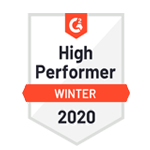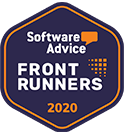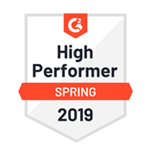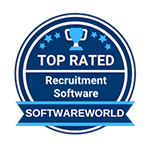The talent acquisition landscape has fundamentally shifted. Traditional job posting strategies that worked just five years ago now yield diminishing returns, while the competition for top talent intensifies across every industry. In this evolved marketplace, mastering advanced sourcing techniques isn’t just advantageous—it’s essential for recruitment success.
Modern sourcing combines strategic thinking, technical expertise, and relationship building to identify and engage candidates who may never see your job postings. With 70% of the global workforce consisting of passive candidates who aren’t actively job searching, organizations that rely solely on applicant flow are missing the majority of available talent.
This comprehensive guide explores cutting-edge sourcing methodologies, from Boolean search mastery to AI-powered candidate identification. Whether you’re building your first sourcing strategy or refining advanced techniques, you’ll discover actionable methods that transform how you find and engage top talent in 2025’s competitive environment.
What is Sourcing vs Recruiting?
Understanding the distinction between sourcing and recruiting is crucial for building effective talent acquisition strategies. While these terms are often used interchangeably, they represent different phases of the hiring process with unique objectives and methodologies.
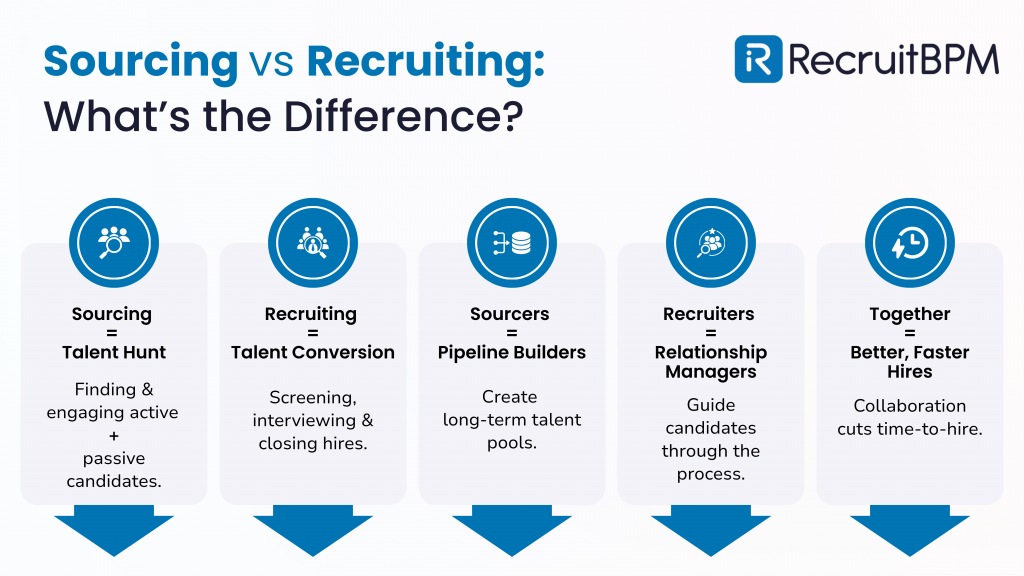
Sourcing Definition and Core Activities
Sourcing is the proactive identification and initial engagement of potential candidates, regardless of their current job search status. It focuses on building talent pipelines and relationships before immediate hiring needs arise. Core sourcing activities include research, candidate identification, database building, and initial outreach to gauge interest and establish connections.
Effective sourcing requires detective-like research skills, combining multiple data sources to create comprehensive candidate profiles. Sourcers analyze social media presence, professional achievements, career progression patterns, and network connections to identify individuals who match specific talent requirements.
Recruiting Process and Responsibilities
Recruiting encompasses the complete hiring process from job requisition through onboarding. It includes sourcing as one component but extends to screening, interviewing, negotiating, and converting candidates into employees. Recruiters manage the entire candidate experience while serving as the primary liaison between candidates and hiring managers.
The recruiting process involves deeper candidate evaluation, cultural fit assessment, and coordinating complex multi-stage interviews. Recruiters must balance speed with quality, ensuring thorough vetting while maintaining competitive time-to-hire metrics.
How Sourcing and Recruiting Work Together?
Modern talent acquisition integrates sourcing and recruiting into seamless workflows. Effective sourcers continuously build talent pipelines that recruiters activate when positions open. This approach dramatically reduces time-to-hire since qualified candidates are pre-identified and engaged.
Advanced organizations maintain dedicated sourcing teams that feed multiple recruiters, creating specialization that improves both sourcing quality and recruiting efficiency. This division of labor allows sourcers to focus entirely on identification and pipeline building while recruiters concentrate on conversion and hiring.
When to Prioritize Sourcing Over Traditional Recruiting?
Sourcing becomes critical when facing talent shortages, competing for passive candidates, or filling highly specialized roles. Markets with low unemployment rates require proactive sourcing since qualified candidates aren’t actively applying. Similarly, executive roles and niche technical positions benefit from targeted sourcing approaches that identify specific individuals rather than hoping for applications.
Organizations should prioritize sourcing investment when traditional recruiting methods show declining effectiveness, when competitor activity intensifies talent competition, or when building long-term talent pipelines for anticipated growth.
Passive Candidate Sourcing: Tapping Into 70% of the Workforce
Passive candidates represent the largest segment of the talent market—professionals who aren’t actively job searching but might consider opportunities that align with their career goals. Mastering passive candidate engagement unlocks access to high-quality talent that competitors miss.
Understanding Passive vs Active Candidates
Passive candidates typically demonstrate higher job performance and longer tenure than active job seekers. They’re often employed in stable positions, making them selective about new opportunities. This selectivity actually benefits employers since passive candidates evaluate opportunities more thoroughly, leading to better cultural fit and reduced turnover.
Active candidates, while immediately available, may be job searching due to performance issues, cultural misalignment, or frequent job hopping. While not universally true, the passive candidate pool often contains more stable, high-performing professionals.
Psychology of Passive Candidate Engagement
Successful passive candidate engagement requires understanding their mindset and motivations. These professionals aren’t dissatisfied with their current roles but may be open to advancement, new challenges, or improved compensation. The key is presenting opportunities as career enhancement rather than job changes.
Passive candidates respond to personalized outreach that demonstrates genuine interest in their background and accomplishments. Generic messages signal mass outreach and typically receive poor response rates. Instead, reference specific projects, achievements, or career progression that show you’ve researched their professional journey.
Crafting Compelling Outreach Messages
Effective passive candidate messages follow a proven structure: personalized opening, value proposition, specific opportunity details, and low-pressure call-to-action. Begin by mentioning something specific from their background that caught your attention. This demonstrates genuine interest rather than automated outreach.
Present the opportunity as a career advancement rather than a job change. Highlight growth potential, learning opportunities, or unique project access that aligns with their career trajectory. Avoid aggressive sales language or pressure tactics that create negative associations with your organization.
Building Long-term Passive Candidate Relationships
Passive candidate sourcing is relationship-driven and requires patience. Many professionals need months or years before considering new opportunities. Maintain regular but respectful contact through valuable content sharing, industry insights, or career advice that positions you as a trusted advisor.
Create talent communities through newsletters, webinars, or informal networking events that keep your organization visible to passive candidates. When opportunities arise, these pre-existing relationships dramatically improve response rates and conversion potential.
Boolean Search Techniques for Talent Sourcing
Boolean search represents the foundation of professional sourcing, enabling precise candidate identification across multiple platforms. Mastering these techniques dramatically improves sourcing efficiency and candidate quality.
Essential Boolean Operators (AND, OR, NOT)
Boolean operators create powerful search combinations that narrow or expand results based on specific criteria. The AND operator requires all terms to appear, creating precise searches: “software engineer” AND Python AND “machine learning” finds candidates with all three qualifications.
The OR operator broadens searches by including alternatives: “developer” OR “programmer” OR “engineer” captures various job title variations. Use parentheses to group OR statements: (“developer” OR “programmer”) AND Python creates logical search hierarchies.
The NOT operator excludes unwanted terms: “marketing manager” NOT “assistant” eliminates junior-level positions. This proves particularly valuable when searching broad terms that return irrelevant results.
Advanced Boolean Search Strings for Recruiters
Professional sourcing requires complex search strings that combine multiple operators and modifiers. Use quotation marks for exact phrases: “project manager” finds this specific title rather than separate words. Asterisks serve as wildcards: “develop*” captures developer, development, and developing.
Create comprehensive search strings for specific roles: (“software engineer” OR “developer” OR “programmer”) AND (“Python” OR “Java” OR “JavaScript”) AND (“startup” OR “tech company”) NOT (“intern” OR “junior” OR “entry-level”). This approach identifies experienced developers in technology environments.
Platform-Specific Boolean Applications
LinkedIn Boolean Search Techniques LinkedIn’s search functionality supports most Boolean operators with some limitations. Use the advanced search filters combined with Boolean strings in the keyword field for maximum effectiveness. Search within specific companies, industries, or geographic areas to narrow results.
Google X-Ray Search Methods X-ray searching uses Google to search within specific websites, bypassing platform limitations. The syntax site:linkedin.com “software engineer” AND Python searches LinkedIn profiles through Google, often returning results not visible through LinkedIn’s native search.
GitHub Developer Sourcing GitHub requires different Boolean approaches since it searches code repositories and user profiles. Search for programming languages in repositories: “language: Python” combined with location filters identifies active developers in specific technologies and geographic areas.
Boolean Search Templates by Role Type
Technical Roles: ((“software engineer” OR “developer” OR “programmer”) AND (“Python” OR “Java” OR “React”) AND (“startup” OR “fintech” OR “saas”) NOT (“student” OR “intern”))
Sales Professionals: ((“sales manager” OR “account executive” OR “business development”) AND (“SaaS” OR “B2B” OR “enterprise”) AND (“quota” OR “targets” OR “revenue”))
Marketing Specialists: ((“digital marketing” OR “growth marketing” OR “performance marketing”) AND (“SEO” OR “PPC” OR “social media”) AND (“analytics” OR “conversion” OR “ROI”))
These templates provide starting points for role-specific searches that can be customized based on specific requirements and industry focus.
AI-Powered Sourcing Tools and Technologies in 2025
Artificial intelligence is transforming talent sourcing by automating repetitive tasks, improving candidate matching accuracy, and providing predictive insights that guide sourcing strategies.
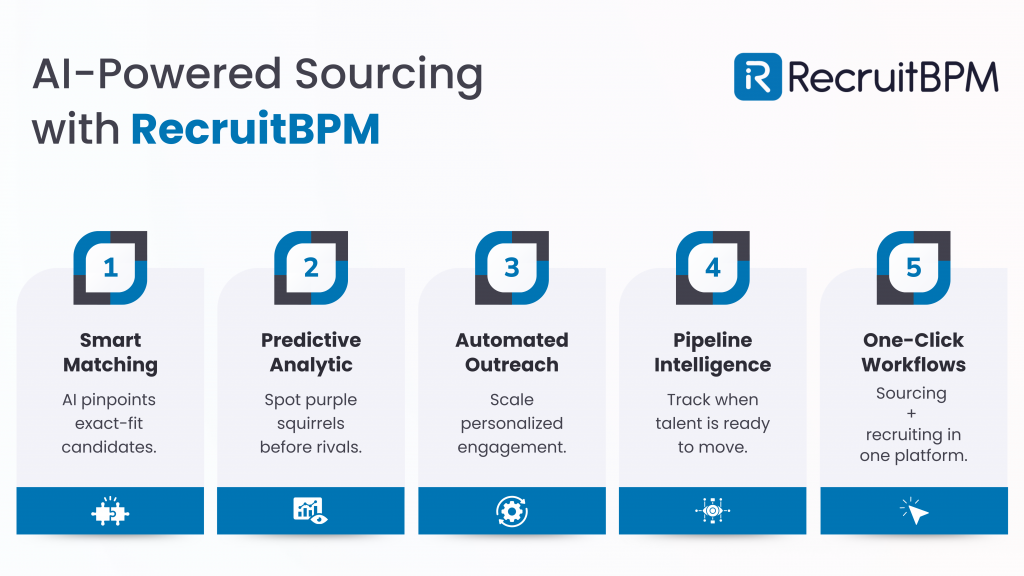
AI Resume Screening and Matching
Modern AI tools analyze resumes using natural language processing to identify skills, experience patterns, and cultural fit indicators. These systems go beyond keyword matching to understand context and career progression, ranking candidates based on comprehensive suitability scores.
AI matching considers factors like career trajectory, skill development patterns, and industry transitions to predict candidate success probability. This approach identifies high-potential candidates who might be overlooked by traditional screening methods.
Predictive Analytics for Candidate Success
Advanced AI platforms analyze historical hiring data to identify patterns that correlate with employee success. These insights guide sourcing strategies by highlighting the characteristics, backgrounds, and experiences that predict high performance in specific roles.
Predictive analytics helps sourcers focus on candidates with success indicators rather than relying solely on obvious qualifications. This approach uncovers hidden talent pools and improves hiring quality metrics.
Automated Candidate Outreach Systems
AI-powered outreach platforms personalize messages at scale by analyzing candidate profiles and suggesting customized communication approaches. These systems optimize send times, subject lines, and message content based on response rate data.
While automation improves efficiency, maintain human oversight to ensure message quality and avoid impersonal communication that damages the employer brand. Use AI to enhance rather than replace human relationship building.
Machine Learning for Talent Pipeline Building
Machine learning algorithms continuously improve sourcing effectiveness by analyzing successful candidate sources, outreach methods, and conversion patterns. These insights guide resource allocation and strategy refinement for maximum sourcing ROI.
Advanced systems predict when passive candidates might be open to new opportunities based on career stage, industry trends, and behavioral signals. This timing intelligence dramatically improves outreach success rates.
ROI of AI Sourcing Tools
Calculate AI sourcing ROI by measuring time savings, improved candidate quality, and increased conversion rates against technology investment costs. Most organizations report 40-60% time savings and 25-35% improvement in candidate quality when implementing AI-powered sourcing tools.
Consider long-term benefits, including reduced agency dependencies, improved talent pipeline quality, and enhanced sourcer productivity when evaluating AI tool investments.
Multi-Channel Sourcing Strategy: Beyond LinkedIn
Effective sourcing requires diverse channel strategies that access different talent pools and reduce dependency on single platforms. Each channel offers unique advantages for specific candidate types and industries.
Social Media Sourcing Platforms
Twitter/X for Thought Leaders Twitter serves as an excellent platform for identifying industry thought leaders, subject matter experts, and professionals who actively share insights. Search for industry hashtags, conference speakers, and content creators who demonstrate expertise and engagement.
Use Twitter’s advanced search functionality to find professionals discussing relevant topics, sharing industry insights, or engaging with company content. These active participants often represent high-quality candidates with strong professional networks.
GitHub for Technical Talent GitHub provides direct access to developers’ actual work through code repositories, contribution history, and collaboration patterns. Analyze commit frequency, project complexity, and community involvement to assess technical capabilities beyond resume claims.
Search by programming language, project type, or contribution patterns to identify developers with specific skills. GitHub’s social features also reveal collaboration abilities and open-source community involvement.
Behance/Dribbble for Creatives: Creative professionals showcase work portfolios on specialized platforms that provide deeper insights than traditional resumes. Evaluate design quality, creative range, and client feedback to assess creative capabilities.
These platforms often include project descriptions that reveal problem-solving approaches, client interaction skills, and creative processes valuable for creative role evaluation.
Professional Association Networks
Industry associations maintain member directories and host networking events that provide access to qualified professionals. These networks often include passive candidates who aren’t visible on general job platforms.
Engage with association events, webinars, and publications to build relationships with potential candidates while establishing your organization as an industry participant.
University and Alumni Networks
University alumni networks provide access to professionals at various career stages with shared educational backgrounds. These connections often respond positively to outreach from fellow alumni or university-affiliated organizations.
Partner with university career services to access recent graduates and establish relationships with faculty who can recommend experienced professionals seeking new challenges.
Industry-Specific Platforms by Sector
Different industries maintain specialized professional networks and platforms. Healthcare professionals use platforms like Doximity, while finance professionals engage through alternative networks beyond LinkedIn.
Research industry-specific platforms and communities where your target candidates gather and engage professionally. These niche networks often provide better candidate quality than general platforms.
Sourcing Workflow and Process Optimization
Systematic sourcing workflows improve efficiency, consistency, and results while enabling measurement and continuous improvement.
Creating Candidate Personas for Targeted Sourcing
Develop detailed candidate personas that include technical skills, experience levels, career aspirations, industry background, and communication preferences. These personas guide sourcing strategy and message customization for improved response rates.
Effective personas combine hiring manager requirements with market research about available talent pools. Include both required qualifications and ideal characteristics that predict success.
Building Sourcing Funnels and Pipelines
Structure sourcing as a funnel process: identification, initial engagement, interest qualification, relationship building, and opportunity presentation. Track conversion rates at each stage to identify improvement opportunities.
Maintain active pipelines for critical roles and skill sets, continuously adding qualified candidates even when positions aren’t immediately available. This approach dramatically reduces time-to-hire when positions open.
Time Management for High-Volume Sourcing
Effective time management balances research depth with candidate volume. Allocate specific time blocks for different sourcing activities: research, outreach, follow-up, and relationship building.
Use technology tools to automate routine tasks while preserving time for high-value activities like personalized outreach and relationship building that drive conversion success.
Organizing and Tracking Sourced Candidates
Implement a systematic candidate organization using tags, categories, and status tracking that enable easy retrieval and relationship management. Include notes about interests, career goals, and communication preferences.
Advanced CRM systems like RecruitBPM provide comprehensive candidate relationship management that tracks all interactions, communications, and status changes throughout extended sourcing cycles.
Measuring Sourcing Effectiveness and ROI
Track key sourcing metrics, including response rates, conversion rates, time-to-hire improvements, and quality of hire scores. Compare sourced candidates against other acquisition channels to demonstrate sourcing value.
Calculate sourcing ROI by measuring cost savings from reduced agency usage, improved time-to-hire, and higher retention rates against sourcing tool and personnel investments.
Advanced LinkedIn Sourcing Techniques
LinkedIn remains the primary professional sourcing platform, but advanced techniques unlock significantly more potential than basic searching provides.
LinkedIn Recruiter provides advanced search filters, InMail messaging, and candidate tracking specifically designed for recruitment. Sales Navigator offers different search capabilities and relationship mapping valuable for passive candidate research.
Recruiter excels in direct candidate identification and outreach, while Sales Navigator provides superior research capabilities for understanding candidate networks and warm introduction opportunities.
X-Ray Search on LinkedIn (Google Site Operators)
Google site operators bypass LinkedIn’s search limitations by searching LinkedIn content through Google. Use site:linkedin.com/in combined with specific keywords to find profiles not returned by LinkedIn’s native search.
Example search: site:linkedin.com/in “software engineer” AND Python AND “San Francisco” finds LinkedIn profiles containing these terms, often returning more comprehensive results than LinkedIn’s internal search.
LinkedIn Groups and Community Sourcing
LinkedIn groups provide access to professionals discussing industry topics and sharing expertise. Engage authentically in group discussions to build relationships and identify potential candidates through their contributions.
Monitor group activity to identify thought leaders, active participants, and professionals demonstrating expertise relevant to your hiring needs. Group engagement often leads to warmer outreach opportunities.
InMail Best Practices and Response Optimization
Effective InMail messages require personalization, clear value propositions, and compelling subject lines. Reference specific aspects of the candidate’s background and explain why you’re reaching out to them specifically.
Test different message formats, subject lines, and send times to optimize response rates. Track performance metrics and continuously refine your InMail approach based on data insights.
LinkedIn Automation Tools and Compliance
While automation tools can improve sourcing efficiency, ensure compliance with LinkedIn’s terms of service, and maintain message quality. Use automation for research and data organization rather than mass messaging that risks account restrictions.
Focus automation on productivity enhancement rather than replacing personalized relationship building that drives sourcing success.
Common Sourcing Challenges and Solutions
Every sourcing professional encounters recurring challenges that require systematic solutions and continuous strategy refinement.
Low Response Rates and Engagement Issues
Low response rates typically indicate poor message personalization, timing issues, or value proposition weaknesses. Analyze successful outreach patterns to identify effective approaches and replicate winning strategies.
Improve response rates through better research, more compelling subject lines, and clearer value propositions that resonate with candidate motivations and career goals.
Candidate Pipeline Drying Up
Pipeline depletion occurs when sourcing focuses too narrowly on specific channels or criteria. Diversify sourcing strategies across multiple platforms, expand search criteria, and explore adjacent skill sets that could transfer successfully.
Continuously refresh and expand sourcing techniques to maintain a robust pipeline flow that supports consistent hiring needs.
Competing with Other Recruiters
Intense competition requires differentiation through superior research, more compelling opportunities, and stronger employer branding. Focus on unique value propositions that set your opportunities apart from generic outreach.
Build relationships before immediate needs arise to gain competitive advantages when opportunities become available.
Sourcing for Hard-to-Fill Positions
Difficult positions require creative sourcing approaches, including skill adjacency analysis, career transition targeting, and geographic expansion. Consider candidates from related industries or roles with transferable skills.
Develop deep market intelligence about talent availability, compensation expectations, and candidate motivations in niche markets.
Maintaining Sourcing Quality at Scale
Scaling sourcing while maintaining quality requires systematic processes, technology leverage, and team training. Standardize research processes, use technology for efficiency gains, and maintain quality control mechanisms.
Balance volume requirements with relationship quality to ensure sourcing efforts drive actual hiring results rather than just activity metrics.
Transform Your Sourcing Strategy with RecruitBPM
Modern sourcing success requires more than individual techniques—it demands integrated workflows that combine multiple channels, relationship management, and analytics-driven optimization. RecruitBPM provides a comprehensive platform that transforms traditional sourcing into a strategic talent acquisition advantage.
How RecruitBPM Enhances Sourcing Efficiency?
RecruitBPM’s unified platform integrates candidate data from multiple sourcing channels, eliminating the inefficiencies of managing separate databases and communication threads. Advanced automation handles routine tasks while preserving time for high-value relationship building that drives conversion success.
The platform’s AI-powered candidate matching analyzes profiles across sourcing channels to identify the most promising prospects, ensuring effort focuses on candidates with the highest conversion probability.
Integrated Sourcing and Recruiting Workflows
RecruitBPM eliminates the traditional handoff challenges between sourcing and recruiting teams by providing seamless workflow integration. Sourced candidates automatically enter structured recruitment processes with complete interaction history and relationship context.
This integration ensures no candidate relationship details are lost while enabling continuous relationship building throughout extended hiring cycles.
Get Started with Advanced Sourcing Today
The future of recruitment belongs to organizations that master proactive sourcing combined with relationship-driven candidate engagement. Advanced sourcing techniques provide sustainable competitive advantages that compound over time through improved talent pipelines and market reputation.
Ready to transform your talent acquisition results through advanced sourcing strategies? Discover how RecruitBPM’s integrated platform can accelerate your sourcing effectiveness while building lasting candidate relationships that drive consistent hiring success.




